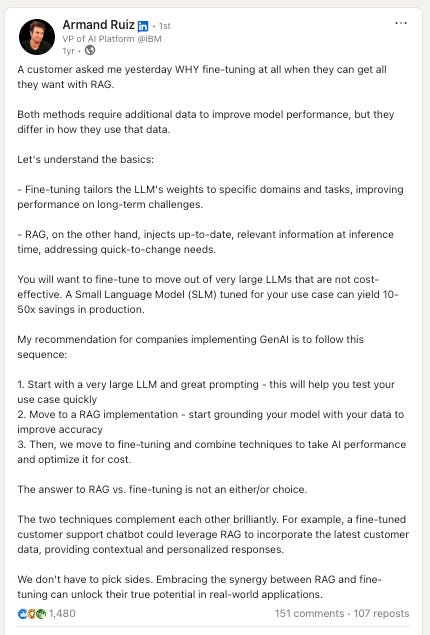The "X vs. Y" Prompt
How Senior Voices Turn Tech Debates into Instant Authority
There's a template destroying engagement on LinkedIn right now that nobody's teaching.
It doesn't pick sides. It doesn't declare winners. It doesn't even pretend to have all the answers. Yet posts using this format are getting 5-10x more engagement than traditional "hot takes" or technical comparisons.
I discovered it by accident while trying to explain RAG vs. Fine-tuning to a client.
Instead of my usual technical deep-dive, I tried something different. The post hit 8.5x my average engagement. Then I tested it again with Monolith vs. Microservices. Same result. And again with Kubernetes vs. Serverless.
The pattern was clear: The "X vs. Y" template works because it transforms tribal technical debates into collaborative learning moments.
🧠 The Psychology Behind X vs. Y Posts
🎯 Why Technical Debates Hook Readers
Every technical professional has strong opinions about tools and approaches.
When you mention "X vs. Y," you're tapping into:
Identity Investment: People define themselves by their technical choices
FOMO Anxiety: Fear they're using the wrong approach
Validation Seeking: Desire to confirm their existing choices
Learning Hunger: Need to understand both sides before deciding
🔄 The Synergy Twist
Most X vs. Y content picks a winner. This template does the opposite - it shows how both approaches complement each other. This psychological judo move:
Disarms defensive readers who came ready to fight
Creates an "aha moment" that feels like insider knowledge
Positions you as strategic and sophisticated, not dogmatic
Encourages sharing because it's helpful, not controversial
💡 The Business Justification Hook
By including a compelling business metric early (like "10-50x cost savings"), you:
Grab executive attention immediately
Transform technical discussion into business strategy
Create urgency around the decision
Make the content shareable up the chain of command
📋 Anatomy of the "X vs. Y" Template
Let's dissect each component and why it works:
🪝 The Customer Hook
"A customer asked me yesterday WHY we should use [X] when they can get all they want with [Y]."Why it works:
Creates immediate relatability (we've all had this conversation)
Positions you as the expert being consulted
Sets up natural storytelling flow
Implies real-world stakes, not theoretical debate
🌉 The Bridge Statement
"Both methods use additional data to improve performance, but they differ in how they use that data."Why it works:
Acknowledges common ground first
Reduces tribal defensiveness
Sets up the comparison naturally
Shows nuanced understanding
📖 Simple Definitions Section
"Let's understand the basics:
[Concept X]: [Simple definition focusing on core function]
[Concept Y]: [Simple definition focusing on core function]"Why it works:
Makes content accessible to all levels
Creates shared vocabulary
Shows you can explain complex topics simply
Builds trust before diving deeper
🧐 The Business Justification
"You will want to use [X] to move out of very large systems that are not cost-effective. A smaller system tuned for your use case can yield 10-50x savings in production."Why it works:
Speaks directly to decision-makers
Provides concrete ROI
Creates urgency
Transforms technical choice into business strategy
🛣️ The Strategic Roadmap
"My recommendation for companies implementing [Field] is to follow this sequence:
1. Start with [Step 1]
2. Move to [Step 2]
3. Then, move to [Step 3]"Why it works:
Provides immediate actionable value
Shows progression and maturity
Reduces decision paralysis
Positions you as strategic advisor
✨ The Synergy Revelation
"The answer to [X] vs. [Y] is not an either/or choice. The two techniques complement each other brilliantly. For example, [Concrete example]"Why it works:
Subverts expectations
Creates memorable insight
Encourages collaboration over competition
Makes readers feel sophisticated
🧑🤝🧑 The Inclusive Close
"We don't have to pick sides. Embracing the synergy between [X] and [Y] can unlock their true potential in real-world applications."Why it works:
Reinforces collaborative message
Encourages engagement from both camps
Positions you above the debate
Creates shareable wisdom
👣 Step-by-Step Implementation Guide
Step 1️⃣: Choose Your X vs. Y Debate
Pick debates that:
Come up repeatedly in client conversations
Have passionate advocates on both sides
Actually complement each other in practice
Matter for business outcomes
Good examples:
LangChain vs. CrewAI
Cloud GPU vs. On-premise GPU
Feature Store vs. Direct Pipeline
Full Training vs. LoRA/PEFT
Batch Processing vs. Real-time Inference
Step 2️⃣: Craft Your Hook Story
The customer question should be:
Specific enough to feel real
General enough to be relatable
Recent ("yesterday" or "last week")
Tied to business impact
Step 3️⃣: Write Crystal-Clear Definitions
For each concept:
One sentence maximum
Focus on what it does, not how
Use analogies if helpful
Avoid jargon completely
Step 4️⃣: Find Your Killer Business Metric
Look for:
Cost savings (10x, 50x, 90%)
Time reduction (weeks to days)
Scale improvements (1K to 1M users)
Risk reduction (99.9% to 99.99%)
Step 5️⃣: Design Your Roadmap
Structure as:
Quick wins (low risk, fast value)
Foundation building (medium complexity)
Optimization (advanced techniques)
Each step should build on the previous one.
Step 6️⃣: Create Your Synergy Example
The example should:
Be specific and visual
Show both technologies working together
Highlight unique strengths of each
Feel like an "aha moment"
Step 7️⃣: Test Your Hook
Before posting, ensure your opening:
Would stop you mid-scroll
Promises value immediately
Feels conversational, not salesy
Creates curiosity gap
Here’s the prompt:
Keep reading with a 7-day free trial
Subscribe to The Tech Audience Accelerator to keep reading this post and get 7 days of free access to the full post archives.



